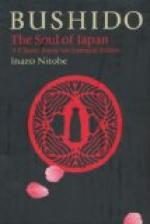[Footnote 23: The game of go is sometimes called Japanese checkers, but is much more intricate than the English game. The go-board contains 361 squares and is supposed to represent a battle-field—the object of the game being to occupy as much space as possible.]
So precious an object cannot long escape the notice and the skill of artists nor the vanity of its owner, especially in times of peace, when it is worn with no more use than a crosier by a bishop or a sceptre by a king. Shark-skin and finest silk for hilt, silver and gold for guard, lacquer of varied hues for scabbard, robbed the deadliest weapon of half its terror; but these appurtenances are playthings compared with the blade itself.
The swordsmith was not a mere artisan but an inspired artist and his workshop a sanctuary. Daily he commenced his craft with prayer and purification, or, as the phrase was, “he committed his soul and spirit into the forging and tempering of the steel.” Every swing of the sledge, every plunge into water, every friction on the grindstone, was a religious act of no slight import. Was it the spirit of the master or of his tutelary god that cast a formidable spell over our sword? Perfect as a work of art, setting at defiance its Toledo and Damascus rivals, there is more than art could impart. Its cold blade, collecting on its surface the moment it is drawn the vapors of the atmosphere; its immaculate texture, flashing light of bluish hue; its matchless




